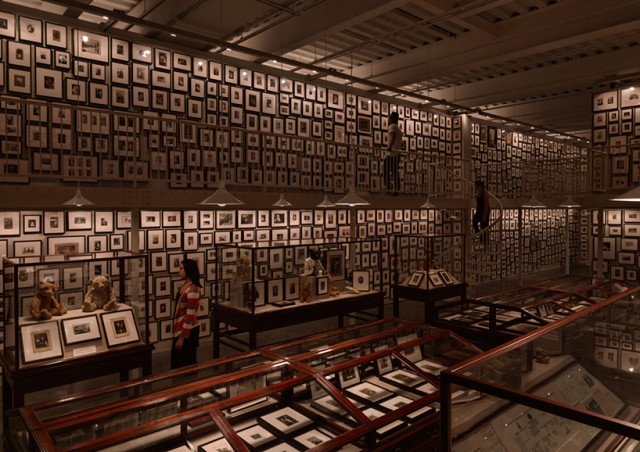
Ydessa Hendeles’s “Partners (The Teddy Bear Project)” dominates one floor of “Keeper” exhibit at New Museum (photo by Maris Hutchinson / EPW Studio)
New Museum of Contemporary Art
235 Bowery at Prince St.
Wednesday through Sunday through September 25, $10-$16
212-219-1222
www.newmuseum.org
Just about everyone collects something. From baseball cards to Wedgwood, coins to stamps, rocks to dolls, and so much else, most people have something they like to stockpile, many to the point of hoarding. The New Museum explores that natural instinct in “The Keeper,” a four-floor extravaganza of unique items that continues through September 25. “‘The Keeper’ is an unusual exhibition in that it multiplies the function of the museum by presenting, within one show, an array of imaginary museums and personal collections — what one might consider to be museums of the individual. Organized as a series of case studies or portraits, ‘The Keeper’ tells the stories of various figures through the objects they chose to protect and preserve — some extraordinarily precious and others apparently trivial or valueless,” museum director Lisa Phillips writes in the catalog foreword. “‘The Keeper,’ of course, is not simply a treatise on collections or on objects and their relative value. Rather, it points beyond these objects to the acts of those who have given themselves the task of safeguarding them, tracing the passions and impulses that inspire their intrepid undertakings, subjective quests, and chronicles of experience.” Spread across three floors plus the glassed-in lobby gallery, “The Keeper” is often reminiscent of the kind of exhibits the old American Folk Art Museum used to mount, particularly Arthur Bispo do Rosário’s tapestries and constructions using cans, dolls, beaded necklaces, bicycle wheels, clothing, and other odd items, created during fifty years in a Rio psychiatric hospital, and Hilma af Klint’s occult paintings, which she did not allow to be seen in public until twenty years after her death in 1944.
![Vanda Vieira-Schmidt Weltrettungsprojekt [World Rescue Project] consists of more than thirty thousand drawings (photo by Maris Hutchinson / EPW Studio)](https://twi-ny.com/wp-content/uploads/2016/09/the-keeper-2-e1474394670620.jpg)
Vanda Vieira-Schmidt’s “Weltrettungsprojekt (World Rescue Project)” consists of more than thirty thousand drawings (photo by Maris Hutchinson / EPW Studio)
Perhaps the most obsessive collection is Ydessa Hendeles’s “Partners (The Teddy Bear Project),” an enormous two-story installation of three thousand vintage family-album photographs in which children pose with a teddy bear, along with related ephemera, spiral staircases, and classic teddy bears in vitrines, a kind of museum exhibition unto itself. Tony Bingxue has preserved sixty-two photographic studio portraits of Ye Jinglu taken in 1901 and then from 1907 to 1968, which reveal a changing culture while calling into questions of authorship. After her family escaped Germany following Kristallnacht, Hannelore Baron started making assemblages using found objects and personal mementos. Novelist Vladimir Nabokov collected butterflies, discovering nearly twenty species and naming them after family members. Yuji Agematsu picks up detritus from New York City streets and displays them in clear plastic wrappers. One of the most fascinating works is Ed Atkins’s The Trick Brain, a sixteen-minute video of found footage that scans André Breton’s personal collection of rare books and tribal artifacts, made after the poet’s death. For The Last Silent Movie, former anthropologist Susan Hiller recorded dozens of endangered or extinct languages, played over a black screen that identifies in white text what language it is and translates what is being said into English. “Today you will get to know me through my tongue,” the last known speaker of K’ora says. It’s a haunting film in an exhibition that ranges from the ridiculous to the sublime while exploring the basic human need to collect, revealing that what we are collecting and preserving is, of course, ourselves, our irreproducible minds with their endless capacity for order and choice. (On Friday, September 23, at 12:30, there will be a New Perspectives tour of the exhibit, “Keeping to Change,” led by New Museum Teaching Fellow Maggie Mustard.)